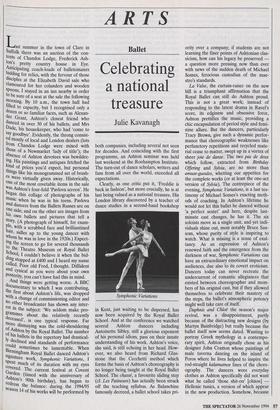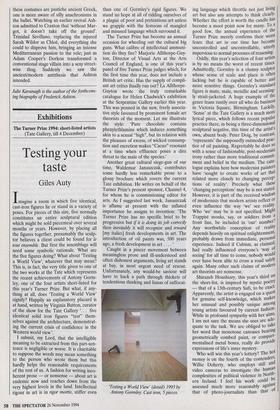ARTS
Ballet
Celebrating a national treasure
Julie Kavanagh
Last summer in the town of Clare in Suffolk there was an auction of the con- tents of Chandos Lodge, Frederick Ash- ton's pretty country house in Eye. Anticipating coach-loads of balletomanes bidding for relics, with the fervour of those disciples at the Elizabeth David sale who clamoured for her colanders and wooden spoons, I stayed in an inn nearby in order to be sure of a seat at the sale the following In °riling. By 10 a.m., the town hall had filled to capacity, but I recognised only a dozen or so familiar faces, such as Alexan- der Grant, Ashton's closest friend who danced in over 30 of his ballets, and Mrs Dade, his housekeeper, who had 'come to say goodbye'. Evidently, the throng consist- ed mostly of local and London dealers (lots from Chandos Lodge were mixed with those of a Newmarket 'lady of title'); the absence of Ashton devotees was bewilder- ing. His paintings and antiques fetched the kind of prices you'd expect, but personal things like his monogrammed set of brush- es were virtually given away. Historically, one of the most covetable items in the sale Was Ashton's four-fold 'Pavlova screen'. He began this collage of photographs of his music when he was in his teens. Pavlova and dancers from the Ballets Russes are on one side; and on the other are images from his own ballets and pictures that tell a story. (A photograph of himself, for exam- ple, with a scrubbed face and brilliantined hair, sidles up to the young dancer with w horn he was in love in the 1920s.) Expect- ing the screen to go for several thousands to the Theatre Museum or Royal Ballet School, I couldn't believe it when the bid- ding stopped at £400 and I heard my name called. Poor old Fred, I thought. Diffident and cynical as you were about your own Posterity, you can't have had this in mind. And things were getting worse. A BBC documentary, to which I was contributing, the first about Ashton's life, was dropped with a change of commissioning editor and no other broadcaster has shown any inter- est in the subject: 'We seldom make pro- grammes about the relatively recently deceased, , is one typical response. Far more dismaying was the cold-shouldering of Ashton by the Royal Ballet. The number of his ballets in the repertory had drastical- ly declined and standards of performance could sometimes be lamentable. When BBingham Royal Ballet danced Ashton's signature work, Symphonic Variations, I spent much of its duration with my eyes covered. The current festival at Covent Garden (timed with the anniversary of Ashton's 90th birthday), has begun to redress the balance: during the 1994/95 season 14 of his works will be performed by both companies, including several not seen for decades. And coinciding with the first programme, an Ashton seminar was held last weekend at the Roehampton Institute. The turn-out of dance scholars, writers and fans from all over the world, exceeded all expectations. Clearly, as one critic put it, 'Freddie is back in fashion', but more crucially, he is at last being valued as a national treasure. His London library discovered by a teacher of dance studies in a second-hand bookshop Symphonic Variations in Kent, just waiting to be dispersed, has now been acquired by the Royal Ballet School. And at the conference we watched several Ashton dancers including Antoinette Sibley, still a glorious exponent of his personal idiom, pass on their innate understanding of his work. Ashton's voice, she said, is still echoing in her head. How- ever, we also heard from Richard Glas- stone that the Cecchetti method which forms the basis of Ashton's choreography is no longer being taught at the Royal Ballet School. The chasse, a favourite sliding step (cf. Les Patineurs) has actually been struck off the teaching syllabus. As Balanchine famously decreed, a ballet school takes pri- ority over a company; if students are not learning the finer points of Ashtonian clas- sicism, how can his legacy be preserved a question more pressing now than ever with news of the sudden death of Michael Somes, ferocious custodian of the mae- stro's standards.
La Vase, the curtain-raiser on the new bill is a triumphant affirmation that the Royal Ballet can still do Ashton proud. This is not a great work; instead of responding to the latent drama in Ravel's score, its edginess and obsessive force, Ashton prettifies the music, providing a chic encapsulation of period style and femi- nine allure. But the dancers, particularly Tracy Brown, give such a dynamic perfor- mance that choreographic weaknesses like perfunctory repetitions and recycled mate- rial cease to matter, swept up in a vortex of sheer joie de danse. The two pas de deux which follow, extracted from Birthday Offering and Sylvia, are no more than amuse-gueules, whetting our appetites for the complete works (or at least the one-act version of Sylvia). The centrepiece of the evening, Symphonic Variations, is a last tes- timony of Michael Somes's exacting meth- ods of coaching. In Ashton's lifetime he would not let this ballet be danced without `a perfect sextet' and here, despite last- minute cast changes, he has it. The six soloists move as a single unit, and yet indi- viduals shine out, most notably Bruce San- som, whose purity of style is inspiring to watch. What is missing is a sense of exul- tancy. As an expression of Ashton's renewed faith and the emergence from the darkness of war, Symphonic Variations can have an extraordinary emotional impact on audiences, due also to its covert eroticism. Dancers today can never recreate the undercurrent of romantic allegiances that existed between choreographer and mem- bers of his original cast, but if they allowed themselves to celebrate their mastery of the steps, the ballet's atmospheric potency might well take care of itself.
Daphnis and Chloe the season's major revival, was a disappointment, partly because of the distracting new designs (by Martyn Bainbridge) but really because the ballet itself now seems dated. Wanting to portray Greek mythology in a contempo- rary spirit, Ashton originally chose as his designer John Craxton whose paintings of male taverna dancing on the island of Poros where he lives helped to inspire the rod-straight kalamatnos lines of the chore- ography. The dancers wore everyday clothes as Ashton specifically did not want what he called 'those shit-on' [chiton] Hellenic tunics, a version of which appear in the new production. Somehow, because these costumes are pastiche ancient Greek, one is more aware of silly anachronisms in the ballet. Watching an earlier revival Ash- ton admitted to Craxton that 'without Mar- got, it doesn't take off the ground'. Trinidad Sevillano, replacing the injured Sarah Wildor as Chloe, did everything she could to disprove him, bringing an intense Mediterranean passion to the role; just as Adam Cooper's Dorkon transformed a conventional stage villain into a sexy street- wise thug. Suddenly we saw the ancient/modern antithesis that Ashton intended.
Julie Kavanagh is the author of the forthcom- ing biography of Frederick Ashton.











































































 Previous page
Previous page